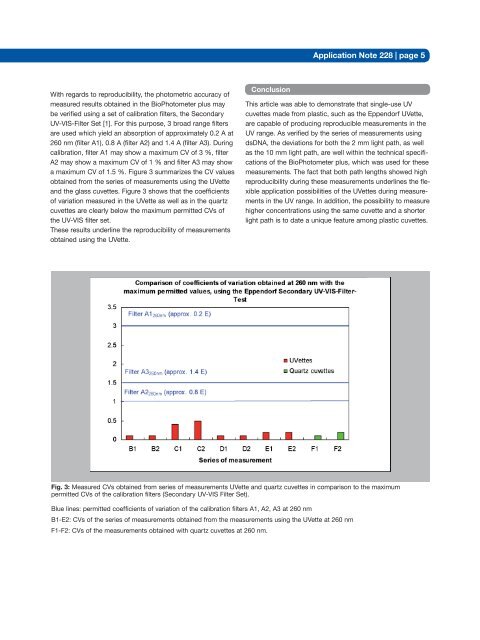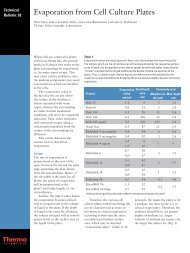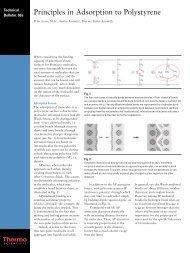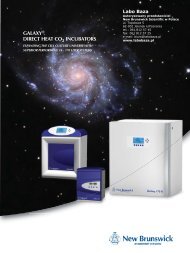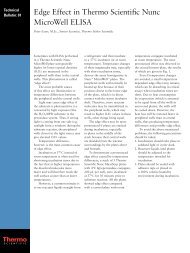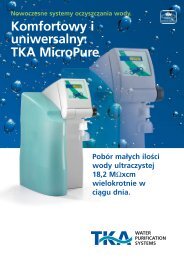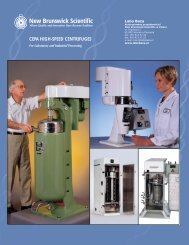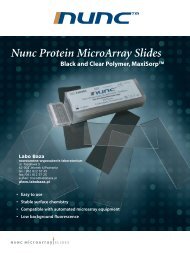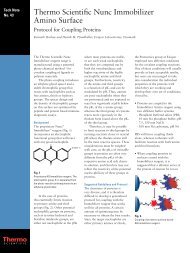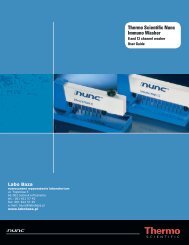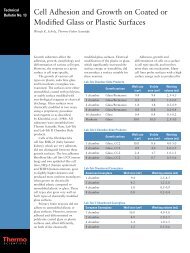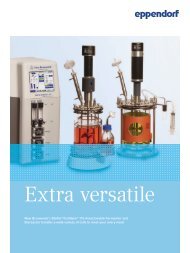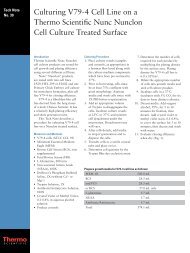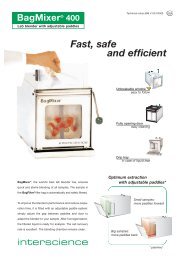Reproducible photometric determination of DNA ... - Labo Baza
Reproducible photometric determination of DNA ... - Labo Baza
Reproducible photometric determination of DNA ... - Labo Baza
Create successful ePaper yourself
Turn your PDF publications into a flip-book with our unique Google optimized e-Paper software.
Application Note 228 | page 5<br />
With regards to reproducibility, the <strong>photometric</strong> accuracy <strong>of</strong><br />
measured results obtained in the BioPhotometer plus may<br />
be verified using a set <strong>of</strong> calibration filters, the Secondary<br />
UV-VIS-Filter Set [1]. For this purpose, 3 broad range filters<br />
are used which yield an absorption <strong>of</strong> approximately 0.2 A at<br />
260 nm (filter A1), 0.8 A (filter A2) and 1.4 A (filter A3). During<br />
calibration, filter A1 may show a maximum CV <strong>of</strong> 3 %, filter<br />
A2 may show a maximum CV <strong>of</strong> 1 % and filter A3 may show<br />
a maximum CV <strong>of</strong> 1.5 %. Figure 3 summarizes the CV values<br />
obtained from the series <strong>of</strong> measurements using the UVette<br />
and the glass cuvettes. Figure 3 shows that the coefficients<br />
<strong>of</strong> variation measured in the UVette as well as in the quartz<br />
cuvettes are clearly below the maximum permitted CVs <strong>of</strong><br />
the UV-VIS filter set.<br />
These results underline the reproducibility <strong>of</strong> measurements<br />
obtained using the UVette.<br />
Conclusion<br />
This article was able to demonstrate that single-use UV<br />
cuvettes made from plastic, such as the Eppendorf UVette,<br />
are capable <strong>of</strong> producing reproducible measurements in the<br />
UV range. As verified by the series <strong>of</strong> measurements using<br />
ds<strong>DNA</strong>, the deviations for both the 2 mm light path, as well<br />
as the 10 mm light path, are well within the technical specifications<br />
<strong>of</strong> the BioPhotometer plus, which was used for these<br />
measurements. The fact that both path lengths showed high<br />
reproducibility during these measurements underlines the flexible<br />
application possibilities <strong>of</strong> the UVettes during measurements<br />
in the UV range. In addition, the possibility to measure<br />
higher concentrations using the same cuvette and a shorter<br />
light path is to date a unique feature among plastic cuvettes.<br />
Fig. 3: Measured CVs obtained from series <strong>of</strong> measurements UVette and quartz cuvettes in comparison to the maximum<br />
permitted CVs <strong>of</strong> the calibration filters (Secondary UV-VIS Filter Set).<br />
Blue lines: permitted coefficients <strong>of</strong> variation <strong>of</strong> the calibration filters A1, A2, A3 at 260 nm<br />
B1-E2: CVs <strong>of</strong> the series <strong>of</strong> measurements obtained from the measurements using the UVette at 260 nm<br />
F1-F2: CVs <strong>of</strong> the measurements obtained with quartz cuvettes at 260 nm.


